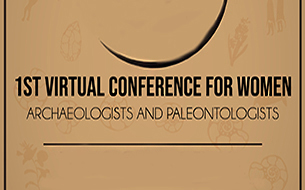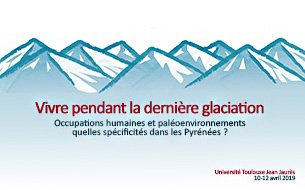Notice
A transdisciplinary approach to reconstruct the Nilotic socio-ecosystem in Luxor west bank during the Ptolemaic period (3rd-1st centuries BC.) / Giulia Nicatore
- document 1 document 2 document 3
- niveau 1 niveau 2 niveau 3
Descriptif
A transdisciplinary approach to reconstruct the Nilotic socio-ecosystem in Luxor west bank during the Ptolemaic period (3rd-1st centuries BC.) / Giulia Nicatore, in colloque "1st Virtual Conference for Women Archaeologists and Paleontologists. Nouveaux apports à l’étude des populations et environnements passés" organisé par le laboratoire Travaux et Recherches Archéologiques sur les Cultures, les Espaces et les Sociétés (TRACES) de l’Université Toulouse Jean Jaurès et le laboratoire Paléontologie Évolution Paléoécosystèmes (PALEVOPRIM) de l'Université de Poitiers, sous la responsabilité scientifique de Julie Bachellerie, Ana Belén Galán López (Traces), Émilie Berlioz et Margot Louail (Palevoprim). Université Toulouse-Jean Jaurès, 8-9 mars 2021.
Session 2 : Occupation of territories and population mobility.
During all its periods, Egyptian society has maintained a privileged relationship with the Nile: the location of housing, and temples has been dictated by the river's course andagricultural land has benefited from the Nile's floods. The understanding of the management of alluvial areas is mainly based on the analysis of the results of archaeological excavations or epigraphic data; geomorphological analyses to reconstruct the fluvial environment of the Nile are still few and often disconnected from the archaeological problems. The aim of this research is the reconstruction of the Nilotic socio-ecosystem of a part of Luxor west bank (called since antiquity "Memnoneia") during the Ptolemaic period (3rd-1st centuries BC.) using a new transdisciplinary approach. This latter combines digital cartography, papyrological analysis and fluvial geomorphology. In this perspective, a selection of sources related to the study area has been identified in order to better understand the fluvial environment and the microtopography of this alluvial plain.
Intervention / Responsable scientifique
Thème
Documentation
Références documentaires
AGUT-LABORDERE, D., 2019, The agricultural landscape of Ayn Manawir
(Kharga Oasis, Egypt) through the Persian period ostraca (vth-ivth
century BC), Abstracta Iranica. Revue bibliographique pour le domaine irano-aryen, 40.41. / in Louise Purdue, Julien Charbonnier, Lamya Khalidi (eds), From refugia to oases. Living
in arid environments from prehistoric times to the present day / Des
refuges aux oasis. Vivre en milieu aride de la Préhistoire à aujourd'hui, Antibes, Éditions APDCA, 2018, 359-377. [En ligne : https://www.academia.edu/37659824/2018_The_agricultural_landscape_of_Ayn_Manawir_Kharga_Oasis_Egypt_through_
the_Persian_period_ostraca_vth_ivth_century_BC_].
BUNBURY, J., 2019, The Nile and Ancient Egypt: Changing Land- and Waterscapes, from the Neolithic to the Roman Era. Cambridge University Press, 200 p.
WILLEMS, H., DAHMS, J.-M. (eds), 2017, The Nile: natural and cultural landscape in Egypt. Bielefeld: Transcript Verlag, coll. Mainz Historical Cultural Sciences, 36, 370 p.
ZAKRZEWSKI, S., SHORTLAND, A., ROWLAND, J., 2015, Science in the study of ancient Egypt. New York, Routledge, 426 p.
NICATORE, Giulia, 2014, Cartografia digitale e modelli predittivi per il Progetto Butehamon, Ægyptica IV, Annali dell’Accademia Egizia, 7-15. [En ligne : https://www.academia.edu/8613034/Cartografia_digitale_e_modelli_predittivi_per_il_progetto_Butehamon].
PARCAK, S., 2009, Satellite Remote Sensing in Archaeology. New York, Routledge, 320 p.
HILLIER, J. K., BUNBURY, J., GRAHAM, A., 2007, Monuments on a migrating Nile, Journal of Archaeological Science, 7, vol. 34, p. 1011-1015.
BUTZER, K.W., 1976, Early hydraulic civilization in Egypt: a study in cultural ecology. Prehistoric archeology and ecology, University of Chicago Press, 134 p. [En ligne : https://oi.uchicago.edu/sites/oi.uchicago.edu/files/uploads/shared/docs/early_hydraulic.pdf].
BOTTI, G., 1967, L'archivio demotico da Deir el Medineh. Catalogo del Museo Egizio di Torino, Serie Prima: Monumenti e testi. 2 volumes.
Liens
Programme du colloque "1st Virtual Conference for Women Archaeologists and Paleontologists" (8-9 mars 2021)
Website du Laboratoire Paléontologie Évolution Paléoécosystèmes Paléoprimatologie (PALEVOPRIM)
Livret des résumés des communications du colloque "1st Virtual Conference for Women Archaeologists and Paleontologists. Nouveaux apports à l’étude des populations et environnements passés" (8-9 mars 2021)
Site internet dédié au colloque "1st Virtual Conference for Women Archaeologists and Paleontologists" (8-9 mars 2021)
>> Accéder à la documentation démotique (site Trismegistos)
Dans la même collection
-
Sensivity analysis to morphological changes of the shoulder joint: application to percussio…
Blasi-ToccacceliAliciaSensivity analysis to morphological changes of the shoulder joint: application to percussion gestures during Oldowan debitage / Alicia Blasi-Toccacceli, in colloque "1st Virtual Conference for
-
"Ouranopithecus macedoniensis" (late Miocene, Greece): analysis of mandibular fragments using …
IoannidouMelaniaOuranopithecus macedoniensis (late Miocene, Greece): analysis of mandibular fragments using 3D geometric morphometrics / Melania Ioannidou, in colloque "1st Virtual Conference for Women
-
Comminution capabilities of extant and fossil anthropoids during molar intercuspation: a preliminar…
WalkerAxelle E. C.Comminution capabilities of extant and fossil anthropoids during molar intercuspation: a preliminary experiment using a chewing simulator / Axelle E. C. Walker, in colloque "1st Virtual Conference for
-
New sperm whale cranium from the late Miocene and a revised family attribution for the small crown …
AlfsenApollineNew sperm whale cranium from the late Miocene and a revised family attribution for the small crown physeteroid Thalassocetus / Apolline Alfsen, in colloque "1st Virtual Conference for Women
-
What is shaping the brain? A perspective on brain size evolution in carnivorans / Margot…
MichaudMargotWhat is shaping the brain? A perspective on brain size evolution in carnivorans / Margot Michaud, in colloque "1st Virtual Conference for Women Archaeologists and Paleontologists. Nouveaux
-
Postnatal shape changes in the rodent mandible at a macroevolutionary scale / Morgane Dubied
DubiedMorganePostnatal shape changes in the rodent mandible at a macroevolutionary scale / Morgane Dubied, in colloque "1st Virtual Conference for Women Archaeologists and Paleontologists. Nouveaux apports à l
-
Cranial vault healing in modern humans: input of archaeological and clinical data / Aliéno…
LepetitAliénorCranial vault healing in modern humans: input of archaeological and clinical data / Aliénor Lepetit, in colloque "1st Virtual Conference for Women Archaeologists and Paleontologists. Nouveaux
-
Tracing Human Ancestral Migration from its Symbiotic Bacteria / Alexia Nguyen Trung
Nguyen TrungAlexiaTracing Human Ancestral Migration from its Symbiotic Bacteria / Alexia Nguyen Trung, in colloque "1st Virtual Conference for Women Archaeologists and Paleontologists. Nouveaux apports à l’étude des
-
From monoliths to megaliths: a new approach on the megalithic burials of southwestern France / Bosc…
BoscusSarahFrom monoliths to megaliths: a new approach on the megalithic burials of southwestern France / Boscus Sarah, in colloque "1st Virtual Conference for Women Archaeologists and Paleontologists. Nouveaux
-
Foragers and their symbolic landscape. Understanding the role of rock art in the territoriality of …
JobardLéaForagers and their symbolic landscape. Understanding the role of rock art in the territoriality of Later Stone Age Matobo populations / Léa Jobard, in colloque "1st Virtual Conference for Women
-
Towards a tracking of past bird seasonal migrations through geological times: what could isotopes t…
DuhamelAnaïsTowards a tracking of past bird seasonal migrations through geological times: what could isotopes tell us? / Anaïs Duhamel, in colloque "1st Virtual Conference for Women Archaeologists and
-
Study of human group behaviors during the Last Glacial Maximum in the east Carpathian area from zoo…
DemayLaëtitiaStudy of human group behaviors during the Last Glacial Maximum in the east Carpathian area from zooarchaeological remains / Laëticia Demay, in colloque "1st Virtual Conference for Women Archaeologists
Sur le même thème
-
GLAMCE - Dater les paysages glaciaires du Forez : combinaison d’une technique low-tech (Marteau de …
RousselErwanAncrenazArthurArthur Ancrenaz et Erwan Roussel, membres de GEOLAB, présentent le projet GLAMCE.
-
Approvisionner le feu en bois. Regard anthracologique sur l’exploitation du Bois des Lens et les us…
VaschaldeChristopheChardonneau-HenneuseJulienApprovisionner le feu en bois. Regard anthracologique sur l’exploitation du Bois des Lens et les usages du combustible par les potiers de l’Antiquité tardive.
-
1.3 : De la paléographie à l'école des chartes
SmithMarcJournée 1, Intervention 3 : De la paléographie à l'école des chartes
-
La circulation des textes grecs ou les chemins du savoir
HoffmannPhilippePour un printemps des savoirs en Méditerranée C ycle de conférences organisé par la Maison méditerranéenne des sciences de l'homme, 31 mars 2009, Aix-en-Provence Rencontre avec : La Méditerranée ou
-
Alfredo Mayoral - « Gergovie : nouvelles recherches géoarchéologiques et paléoenvironnementales »
Le jeudi 16 septembre 2021, à 20h30, sur Facebook, Page Musée de Gergovie, Alfredo Mayoral, géoarchéologue, à l'Institut Catalan d’Archéologie Classique et à GEOLAB (UMR 6042 CNRS / UCA UNILIM), a
-
M. DJAMALI et M. MASHKOUR, Réflexions sur la contribution des coprolithes de hyènes modernes comme …
Réflexions sur la contribution des coprolithes de hyènes modernes comme référentiel pour les reconstitutions paléoenvironnementales. Morteza DJAMALI1, Marjan MASHKOUR2 1-CNRS, IMBE (morteza
-
"Ouranopithecus macedoniensis" (late Miocene, Greece): analysis of mandibular fragments using …
IoannidouMelaniaOuranopithecus macedoniensis (late Miocene, Greece): analysis of mandibular fragments using 3D geometric morphometrics / Melania Ioannidou, in colloque "1st Virtual Conference for Women
-
What is shaping the brain? A perspective on brain size evolution in carnivorans / Margot…
MichaudMargotWhat is shaping the brain? A perspective on brain size evolution in carnivorans / Margot Michaud, in colloque "1st Virtual Conference for Women Archaeologists and Paleontologists. Nouveaux
-
Neanderthal facing climatic disruptions of the MIS 4 in southwestern France: between cynegetic choi…
DancetteChristelleNeanderthal facing climatic disruptions of the MIS 4 in southwestern France: between cynegetic choices and environmental constraints / Christelle Dancette, in colloque "1st Virtual Conference for
-
Revising the microvertebrates from the Palaeolithic site of Kalamakia (Mani Peninsula), Greece / Ko…
KolendrianouMariaRevising the microvertebrates from the Palaeolithic site of Kalamakia (Mani Peninsula), Greece / Kolendrianou Maria, in colloque "1st Virtual Conference for Women Archaeologists and Paleontologists.
-
Vivre pendant la dernière glaciation. Occupations humaines et paléoenvironnements : quelles spécifi…
LejayMathieuVivre pendant la dernière glaciation. Occupations humaines et paléoenvironnements : quelles spécificités dans les Pyrénées ? Introduction / Mathieu Lejay
-
Environnements glaciaires et fluvioglaciaires dans les Pyrénées au cours de la dernière Terminaison…
DelmasMagaliEnvironnements glaciaires et fluvioglaciaires dans les Pyrénées au cours de la dernière Terminaison glaciaire / Magali Delmas












































